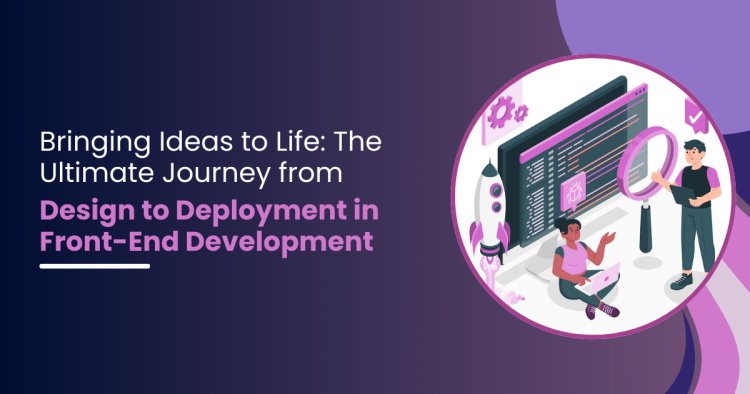Bringing Ideas to Life: The Ultimate Journey from Design to Deployment in Front-End Development
Discover the complete process of front-end development, from design to deployment. Learn how design, coding, testing, and deployment work together to create seamless, user-friendly websites and apps.

In today’s digital world, front-end development plays a vital role in shaping user experiences and website interactions. With over 1.9 billion websites currently on the internet, the demand for front-end development services continues to grow. As of 2023, it was reported that 58% of developers consider front-end development as a major focus in their projects. A strong online presence can make or break a business, which is why working with a skilled front-end development company is essential. But how does the journey from design to deployment unfold? This article will guide you through the entire process, explaining key stages, important technologies, and tips on how to hire a front-end developer for your project.
Understanding Front-End Development
What is Front-End Development?
Front-end development refers to the creation of the visual and interactive aspects of a website or application that users directly interact with. The front-end is responsible for everything a user experiences, including layout, design, buttons, text, images, and navigation. In essence, it is the "face" of the application that defines the user interface (UI) and user experience (UX).
The Importance of Front-End Development
In a world where user experience can influence conversion rates, front-end development holds immense significance. A well-structured, responsive, and user-friendly interface keeps visitors engaged, reducing bounce rates and increasing user retention. Businesses can directly benefit from a robust front-end, leading to increased sales, brand loyalty, and overall growth.
The Stages of Front-End Development
1. Design Phase
Before any code is written, designers work closely with stakeholders to create wireframes and prototypes. This is where the visual elements of the website or application take shape. Tools like Figma, Sketch, and Adobe XD are commonly used for this stage.
Key Components of the Design Phase:
-
Wireframes: Basic layouts without any design elements to plan the structure.
-
Mockups: More detailed visual representations showing colors, fonts, and images.
-
Prototypes: Interactive models that demonstrate how the application will work.
2. Development Phase
Once the design is approved, it’s time for front-end developers to turn these static mockups into functioning code. This phase involves the use of several programming languages and frameworks.
Tools and Technologies Used in Front-End Development:
-
HTML (HyperText Markup Language): The foundation of web pages that structures content.
-
CSS (Cascading Style Sheets): Styles the layout, fonts, and colors, ensuring the website is visually appealing.
-
JavaScript: Adds interactivity and dynamic behavior to web pages.
-
Frameworks: React, Angular, and Vue.js are some of the popular JavaScript frameworks that simplify complex tasks and improve efficiency.
3. Testing Phase
Before deployment, it is crucial to ensure that everything works as intended. Front-end developers use various testing methods to check for bugs, performance issues, and cross-browser compatibility.
Common Testing Methods:
-
Unit Testing: Tests individual components of the code to ensure they work correctly.
-
Integration Testing: Tests the interaction between different components of the system.
-
Browser Testing: Ensures the website works across different browsers (Chrome, Firefox, Safari, etc.).
4. Deployment Phase
Once testing is complete and all bugs are resolved, it’s time for the deployment phase. Deployment involves transferring the website or application to a live environment, making it available to the public.
Key Tools for Deployment:
-
Git: A version control system used to track changes and collaborate on code.
-
CI/CD (Continuous Integration/Continuous Deployment): Automated processes that help deploy updates and maintain code integrity.
5. Maintenance Phase
After deployment, the website or application needs ongoing maintenance. Regular updates, bug fixes, and performance enhancements are essential to keep the front-end running smoothly.
Also Read: Developing BNPL (Buy Now, Pay Later) Solutions: Tech Stack and Architecture
Key Skills for Front-End Developers
1. HTML/CSS Expertise
A front-end developer must have in-depth knowledge of HTML and CSS, as these are the building blocks for structuring and styling websites. They should be comfortable with responsive design techniques, ensuring the site looks good on all devices.
2. JavaScript Proficiency
JavaScript is the backbone of interactive websites. Front-end developers must have expertise in Vanilla JavaScript and popular JavaScript frameworks like React, Angular, or Vue.js to create dynamic and fast-loading websites.
3. Version Control Skills
Version control systems like Git are essential for managing and tracking changes to the codebase. Developers must be familiar with Git commands, branching, and collaboration features.
4. UI/UX Understanding
While not mandatory, having a solid understanding of user interface (UI) and user experience (UX) principles allows developers to create websites that are not only functional but also intuitive and user-friendly.
Also Read: Freelancer vs. Agency: Which Is the Best Choice for Hiring a Front-End Programmer?
Choosing the Right Front-End Development Company
Selecting the right front-end development company can significantly impact the outcome of your project. It’s crucial to assess the company’s skills, portfolio, and experience before making a decision.
Factors to Consider:
-
Experience in Your Industry: Does the company have experience building websites or applications in your specific industry?
-
Portfolio: Review the company’s past work to understand their design and development capabilities.
-
Expertise with Technologies: Ensure the company is proficient in modern front-end technologies like React, Vue.js, and CSS frameworks such as Bootstrap or Tailwind CSS.
-
Communication and Collaboration: Effective communication is key to a successful project. Ensure the company is responsive and collaborative throughout the process.
How to Hire a Front-End Developer
Hiring the right front-end developer is crucial for bringing your vision to life. Here are some tips to guide your decision-making process:
1. Define Your Requirements
Before starting your search, list the key skills and qualities you’re looking for in a front-end developer. Do you need someone experienced in React, or is a general knowledge of HTML, CSS, and JavaScript sufficient? Understanding your project’s needs will help you find the right candidate.
2. Look for Relevant Experience
When reviewing resumes, focus on candidates with experience that aligns with your project’s requirements. This includes familiarity with the necessary technologies, frameworks, and tools, as well as past experience working on similar projects.
3. Assess Problem-Solving Abilities
During the interview process, assess the candidate’s ability to solve real-world development problems. Front-end development often involves debugging issues and adapting to changes in design. Candidates should be able to demonstrate strong problem-solving skills.
4. Consider Freelancers vs. Agencies
While hiring a freelancer may be a cost-effective option, front-end development companies typically offer more resources and experience for larger projects. Weigh the pros and cons based on your specific needs.
5. Evaluate Soft Skills
A successful front-end developer isn’t just skilled in coding they should also possess good communication and teamwork skills. Make sure the candidate can work collaboratively with designers, back-end developers, and other stakeholders.
Best Practices in Front-End Development
1. Responsive Design
A responsive design ensures your website or application adapts seamlessly to different screen sizes, from desktops to smartphones. This is especially important as mobile traffic accounts for over 50% of global web traffic.
2. Optimized Performance
Website performance is crucial to retain visitors. Slow-loading sites often result in higher bounce rates. Front-end developers should focus on optimizing images, minimizing code, and using techniques like lazy loading to enhance speed.
3. Accessibility
Ensuring that your website is accessible to all users, including those with disabilities, is critical. Front-end developers should follow accessibility standards (WCAG) to create inclusive digital experiences.
4. Cross-Browser Compatibility
Front-end developers must test and ensure their websites function well across all major browsers. Browser compatibility is essential to ensure a consistent experience for all users, regardless of their preferred browser.
Conclusion
The journey from design to deployment in front-end development is a comprehensive process that requires attention to detail, collaboration, and a deep understanding of web technologies. By choosing the right front-end development company and hiring a front-end developer with the right skills, businesses can ensure a seamless and engaging user experience. As front-end development continues to evolve, staying up-to-date with the latest tools, frameworks, and best practices will be essential for building websites and applications that stand out in today’s competitive market.
What's Your Reaction?





















